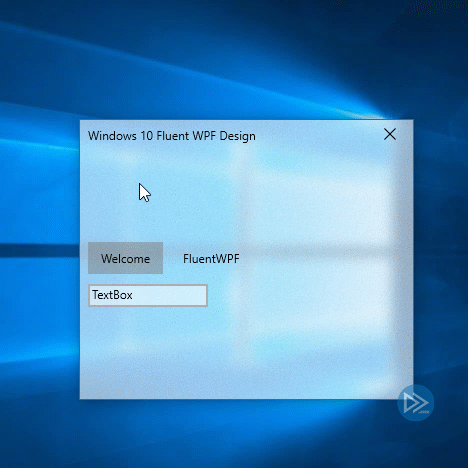FLuentWPF
You know Mahapps or Material Design and now we have the opportunity to use FluentWPF with PowerShell and XAML
1. FluentWPF
We can find the source on a MVP Jan Karger Github repository here or if we use Visual Studio Community 201-5-7 you can manage Nuget Package
Install-Package FluentWPF
1.1 Visual
First view Acrylic

Second view Reveal

1.2 How to use it
In your XAML code you need to insert a reference to FluentWPF
- Insert the reference in the XAML code
<Window
xmlns="http://schemas.microsoft.com/winfx/2006/xaml/presentation"
xmlns:x="http://schemas.microsoft.com/winfx/2006/xaml"
xmlns:fw="clr-namespace:SourceChord.FluentWPF;assembly=FluentWPF"
Title="Windows 10 Fluent WPF Design"
Height="281" Width="335"
WindowStartupLocation="CenterScreen"
ResizeMode="NoResize"
fw:AcrylicWindow.Enabled="True">
- Insert ResourceDictionary in the XAML code
<Window.Resources>
<ResourceDictionary>
<ResourceDictionary.MergedDictionaries>
<ResourceDictionary Source="resources\Icons.xaml" />
<ResourceDictionary Source="pack://application:,,,/FluentWPF;component/Styles/Controls.xaml" />
</ResourceDictionary.MergedDictionaries>
</ResourceDictionary>
</Window.Resources>
1.2 Basic Interface with 2 buttons
XAML File
<Window
xmlns="http://schemas.microsoft.com/winfx/2006/xaml/presentation"
xmlns:x="http://schemas.microsoft.com/winfx/2006/xaml"
xmlns:fw="clr-namespace:SourceChord.FluentWPF;assembly=FluentWPF"
Title="Windows 10 Fluent WPF Design"
Height="281" Width="335"
WindowStartupLocation="CenterScreen"
ResizeMode="NoResize"
fw:AcrylicWindow.Enabled="True">
<Window.Resources>
<ResourceDictionary>
<ResourceDictionary.MergedDictionaries>
<ResourceDictionary Source="resources\Icons.xaml" />
<ResourceDictionary Source="pack://application:,,,/FluentWPF;component/Styles/Controls.xaml" />
</ResourceDictionary.MergedDictionaries>
</ResourceDictionary>
</Window.Resources>
<Grid fw:PointerTracker.Enabled="True" Background="#01FFFFFF" Margin="3">
<StackPanel VerticalAlignment="Center">
<StackPanel Orientation="Horizontal">
<Button Name="Welcome" Content="Welcome" HorizontalAlignment="Left" Margin="5" Width="75" Height="32"
Style="{StaticResource ButtonRevealStyle}"/>
<Button Name="FluentWPF" Content="FluentWPF" HorizontalAlignment="Left" Margin="5" Width="75" Height="32"
Background="Transparent"
Style="{StaticResource ButtonRevealStyle}" />
</StackPanel>
<TextBox HorizontalAlignment="Left" Height="23" Margin="5" Text="TextBox" Width="120"
Style="{StaticResource TextBoxRevealStyle}"/>
</StackPanel>
</Grid>
</Window>
PowerShell Script
The file FluentWPF.dll is in a directory Assembly like Mahapps project.
##Initialize######
[System.Reflection.Assembly]::LoadWithPartialName('presentationframework') | out-null
[System.Reflection.Assembly]::LoadFrom('assembly\FluentWPF.dll') | out-null
[String]$ScriptDirectory = split-path $myinvocation.mycommand.path
#$ScriptDirectory =(get-location).path
function LoadXml ($global:filename)
{
$XamlLoader=(New-Object System.Xml.XmlDocument)
$XamlLoader.Load($filename)
return $XamlLoader
}
# Load MainWindow
$XamlMainWindow=LoadXml("$ScriptDirectory\Main.xaml")
$Reader=(New-Object System.Xml.XmlNodeReader $XamlMainWindow)
$Form=[Windows.Markup.XamlReader]::Load($Reader)
$Welcome=$Form.FindName("Welcome")
$FluentWPF=$Form.FindName("FluentWPF")
$FluentWPF.add_Click({
$form.Close()
})
$Form.ShowDialog() | Out-Null
2. The result

Written by Jérôme Bezet-Torres @JM2K69.